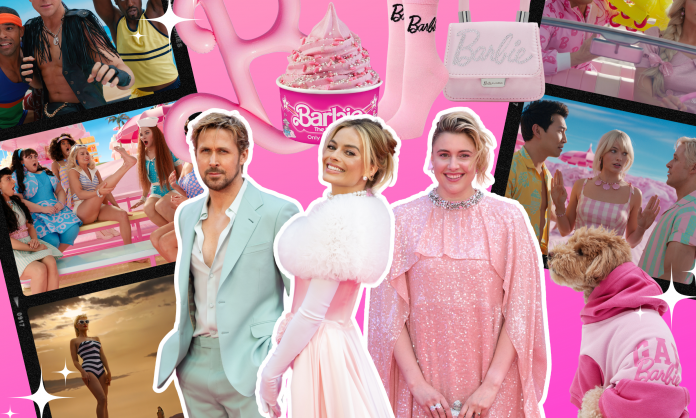Barbie, Mattel and Greta Gerwig’s multi-million-dollar confection of nostalgia and hot pink, is a blockbuster hit and a bona fide cultural phenomenon. The film has taken in more than a billion dollars at the box office and inspired scores of breathless articles, everywhere from the mainstream press to the far left, extolling it as an artistic and political masterpiece.
But Barbie’s tale of the famous doll grappling with real-life sexism and the complicated world of human feelings left me cold. The film’s plot was frequently directionless and overly saccharine. I developed a grim respect for Margot Robbie and Ryan Gosling (Barbie and Ken) who work hard to carry off the script. But outside of a few satisfying gags, I found much of the humour over-reliant on a stale self-reflexivity and nostalgia factor for the little plastic doll. Opulently detailed and faithful set design, some impressive dance numbers and a too-brief car chase are entertaining, but not enough to save the two-hour runtime from dragging.
That’s this humble critic’s opinion. But this review wouldn’t exist if Barbie’s only crime was being a bit crap. Barbie is worthy of criticism because it has succeeded in making controversial what once was such a basic observation as to be virtually hackneyed amongst progressives: Barbie is a sexist toy. For at least 50 years the doll has been seen as the embodiment of the pressure to fulfil impossible beauty standards imposed on women; playing with Barbies is associated with increased negative body image in girls as young as five.
But thanks to the Barbie movie, she’s back in business, with a progressive facelift that has made it positively uncool to point out the misogyny behind the pastel dreamworld.
The film’s genesis lies in a concerted campaign by Mattel to rehabilitate Barbie. Between 2009 and 2016, Barbie’s market share decreased virtually year on year. Mattel’s focus groups indicated this was in part due to a younger generation of parents refusing to buy Barbies for their children because she peddles sexist stereotypes. Mattel saw the writing on the wall and decided it was time to revamp her image. They released a line of dolls with different body types and ethnicities, alongside an overhaul of Barbie’s advertising. The strategy worked: in 2022, Barbie reclaimed her top spot in the dress up doll market.
It says a lot that the brand’s most progressive credential in the last two decades is the release of a “curvy” Barbie whose waist measurement, contra original Barbie, would just about allow for a complete liver. But Barbie’s new “inclusive” range of body types, skin tones and career ambitions haven’t in fact cleansed her of sexist content. The point of Barbie is that you can be a doctor, a head of state, a vet, or a teacher—you can even be “curvy”, or not white, or disabled—and still be an attractive object for others to look at. (As it happens, the main Doctor Barbie currently sold by Mattel isn’t, in fact, called “Doctor Barbie”, or even “Paediatrician Barbie”—she’s “Baby Doctor Barbie”, complete with two infants to care for and a pink bedazzled stethoscope.)
Regardless, the main character is still “Stereotypical Barbie”, with shiny blonde hair, blue eyes and long tanned legs.
Producing a Barbie movie that slyly pokes fun at the brand and makes descriptive observations about the sexist double standards women face is congruent with this new marketing strategy. It’s a conscious tactic for rehabilitating the toy with an audience Mattel has struggled with, by convincing us that it’s okay to love Barbie even if you hate sexism.
Most of the media coverage and online discussions of the Barbie movie celebrate its digs at Mattel as a profound and nuanced—even anti-capitalist—critique of the Barbie brand. But the movie’s in-jokes and winks to the camera about the sexist stereotypes built into Barbie, the corporate nature of Mattel and the obvious vacuousness of releasing new versions of a plastic doll as a strategy for fighting real-world sexism, are exactly what enable it to function as a Barbie ad for the 2020s. Because you know that I know that Greta Gerwig knows that Barbie knows that Barbie is a sexist consumer product, we’re freed up to set all that aside while the film does its best to convince us of its core argument that she can be whatever you want her to be.
Most of the film’s Barbie-critical sentiments are delivered via dramatic irony. The effect isn’t to imbue them with clever subtlety. It’s to soften them, to push them to the side. The only time an anti-Barbie bit of dialogue is delivered directly and straight faced, the audience is intended to regard it as a bit ridiculous: the character, cynical teenager Sasha, escalates from saying Barbie perpetuates sexist beauty standards to calling her a fascist. “I don’t control the trains or the flow of commerce!” Barbie wails. So, criticising Barbie to her face is way harsh and over the top.
The character arc of Sasha, played by Ariana Greenblatt, is worth narrowing in on, because it’s one of the more egregious examples of Barbie’s sexism and a metonym for the broader argument the film is making. Sasha is introduced as a smart and self-assured young woman, furious at the sexism society heaps on her. As far as the film is concerned, this is reflective of an unfortunate rigidity on Sasha’s part, which has driven a wedge between her and her mother, America Ferrera’s Gloria.
It’s resolved by Sasha and Gloria travelling to Barbieland, where Sasha learns to relax a little and fall back in love with the magical potential of Barbie. To underscore this transformation, each time she appears on screen, Greenblatt’s hair, makeup and costume is more elaborate, more feminine and more pink. The relationship between mother and daughter is healed, and Sasha returns to the real world all the better for having embraced the Barbie within.
Being a jaded teenage girl with a rage against totems of sexism like Barbie is great. I would recommend it to anybody who asked. This adolescent feminist anger can be an early step on the way to arriving at a more worked out set of politics. One of the worst moments in the film is when Sasha is used to impress on its audience of mostly young women that our best chance of being liked and happy is instead to walk back down its pink-dream-house-lined political and cultural cul-de-sac.
Another line of defence for Barbie argues that attacks on the film by sexist internet ideologues like Ben Shapiro are evidence of its left-wing content. Frankly, a lot of not particularly left-wing things upset the far right, including Target selling rainbow T-shirts, Hillary Clinton’s presidential run and Mars switching the green MnM’s high heels to sneakers.
Beyond this, the main conflict of the film, in which Gosling’s Ken and his counterparts transform Barbieland into Kendom and dupe the Barbies into accepting a patriarchal order, effectively rests on talking points that would hardly seem out of place in Shapiro’s videos. The reason the Kens seek domination over the Barbies is that they’re unfulfilled; they don’t get enough attention from the Barbies, they’re treated dismissively, and all the jobs are taken by women! By the time the saga has reached its conclusion, via a musical number about these long-oppressed men becoming self-actualised, Robbie’s Barbie is made to apologise to Ken, acknowledging that she is at fault for failing to care about his feelings.
This dramatic arc mirrors Barbie’s prescriptions for women in the fight against sexism: just change your mindset around gender roles, reclaim #Barbiecore or declare yourself “Kenough”. Empowerment is achieved as an individual, and it can be whatever makes you feel good, regardless of its political content or social impact. It’s a version of anti-sexism that centres on finding self-fulfilment through an enthusiastic embrace of the gender stereotypes imposed on you—it’s subversive, don’t you know.
The film hits us on the head repeatedly with the notion that Barbie is an “open-ended” idea, including through a ghostly visit by Ruth Handler, original Mattel capitalist and inventor of Barbie, played by Ruth Pearlman. Between gag-inducing lines like “I do all my best thinking at the kitchen table” and “mothers stand still so daughters can see how far they’ve come”, Handler informs us that Barbie has evolved with the times and transcended her sexist origins.
At one point, during a monologue that’s clearly meant to be the film’s major anti-sexist statement, Barbie tips into suggesting that it’s for the best that these dolls are designed as flawless, pretty objects; if she had room for a complete large intestine, she’d just remind women of their own struggles in a sexist society. Barbie isn’t just redeemable, she’s inspirational, a welcome window of escapism. Mattel executives everywhere weep with joy. Now that it’s uncool for Barbie to be a misogynistic cash grab, better for her to become a plastic-fantastic, O-T-T, so-bad-it’s-good idea that will help you unlock your fun, pretty, authentic self in a world of harsh realities.
It’s easy to feel cynical about the moral that Barbie is a creative canvas for us modern women to do with what we will when we see that the movie has come into the world saturated with brand tie-ins (the marketing budget outstripped production spending). You can buy Barbie-branded everything from eyeshadow and nail polish to thistle tea, which tabloid magazines will tell you Robbie drank on set to “detox her liver” and achieve flawless Barbie-like skin (here’s to authentic self-expression!). Perhaps we’re meant to think all these products are also just empowering creative ideas. Let’s not buy it.










